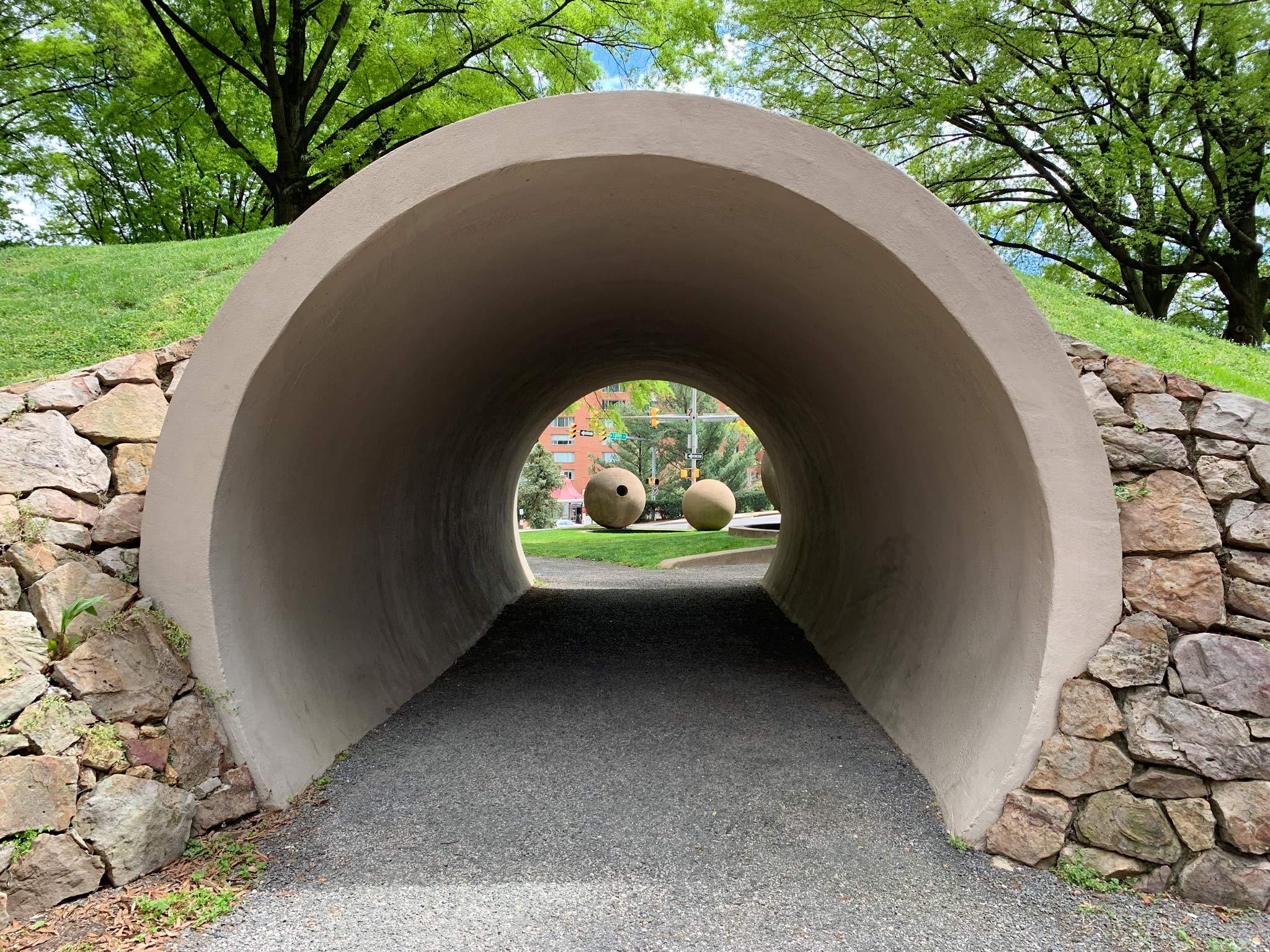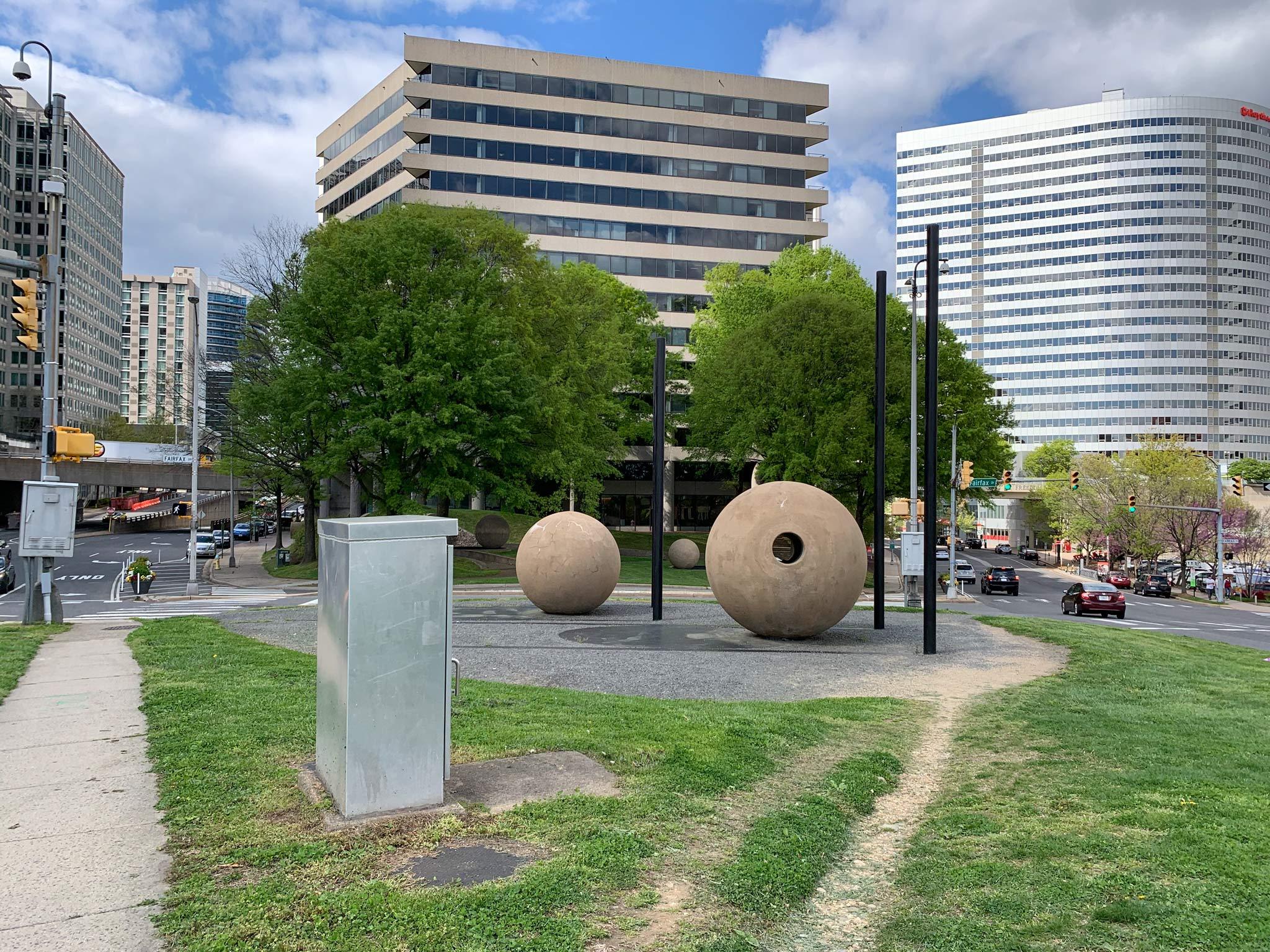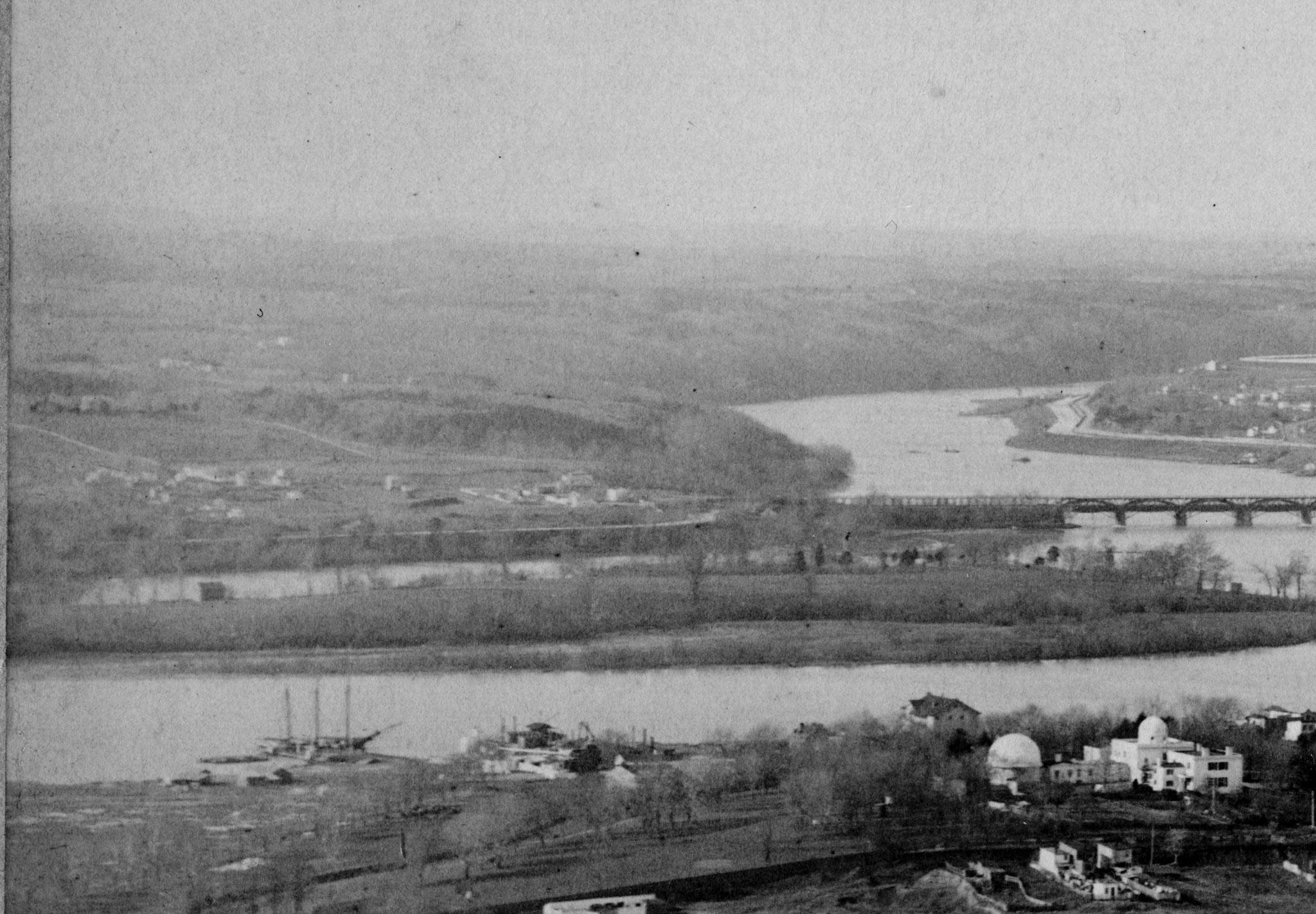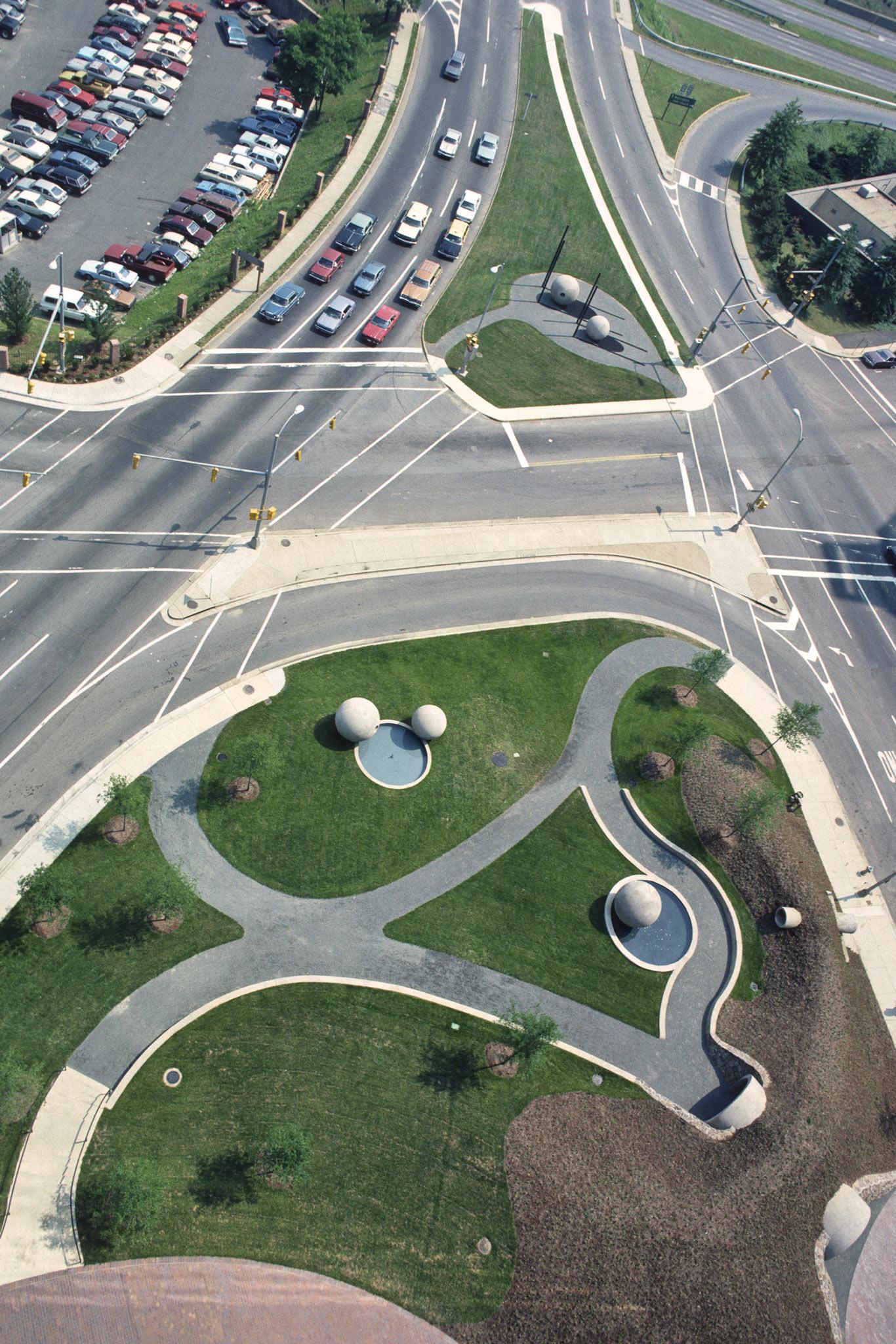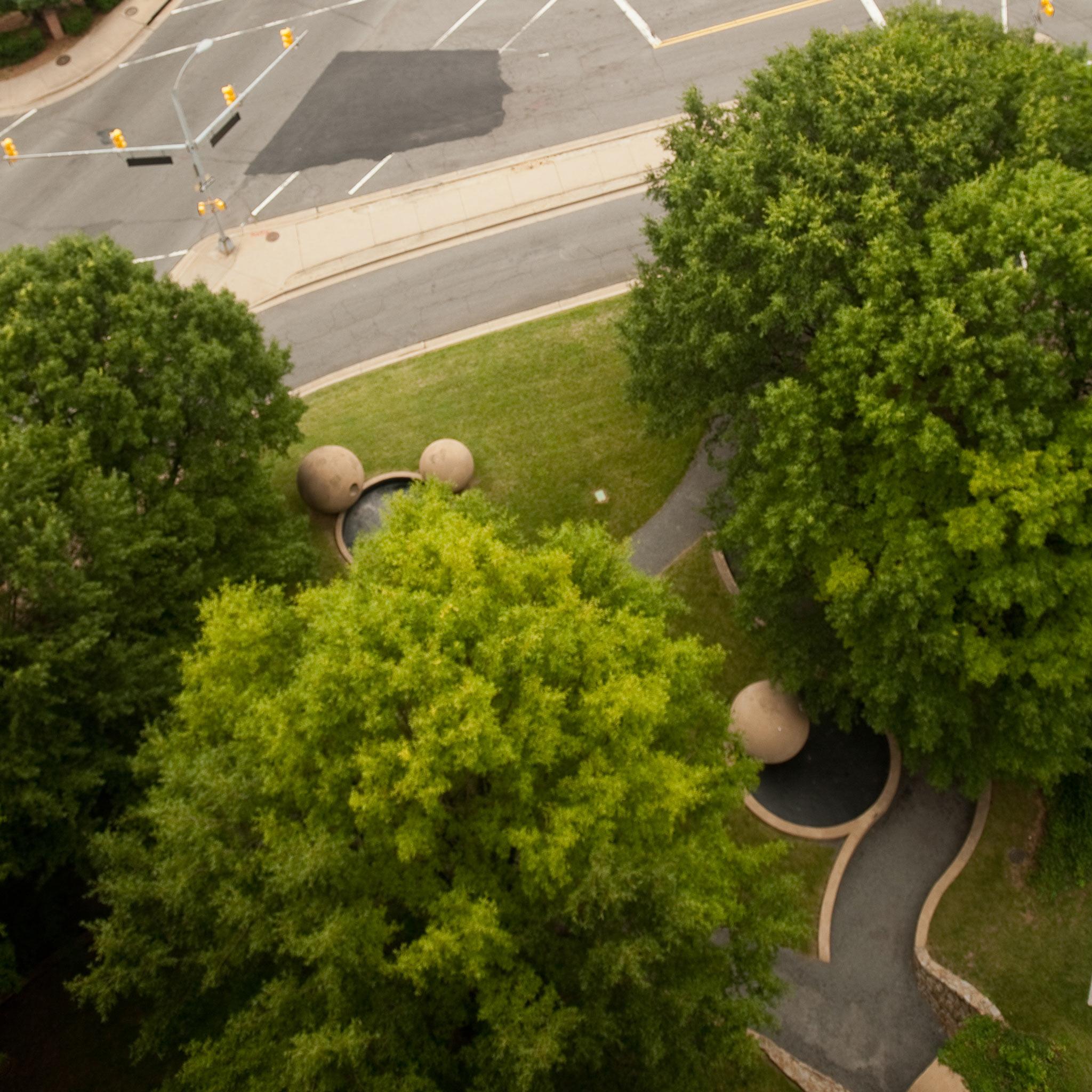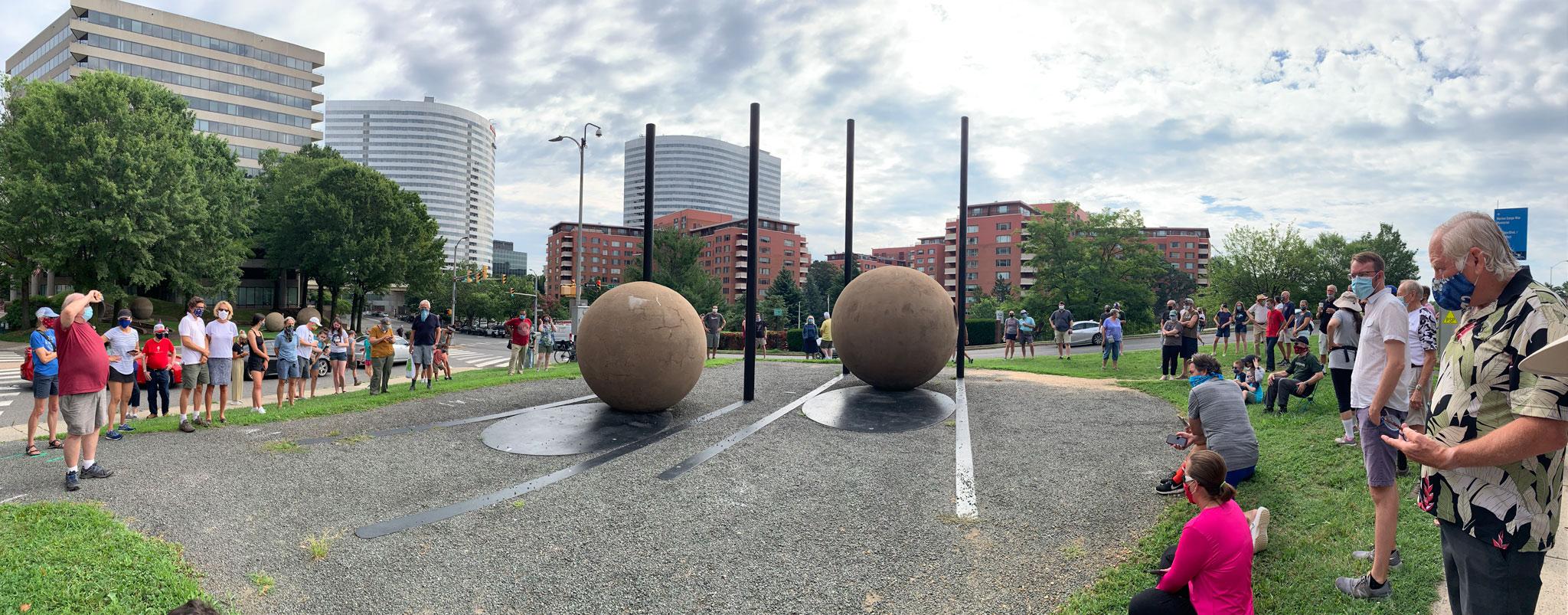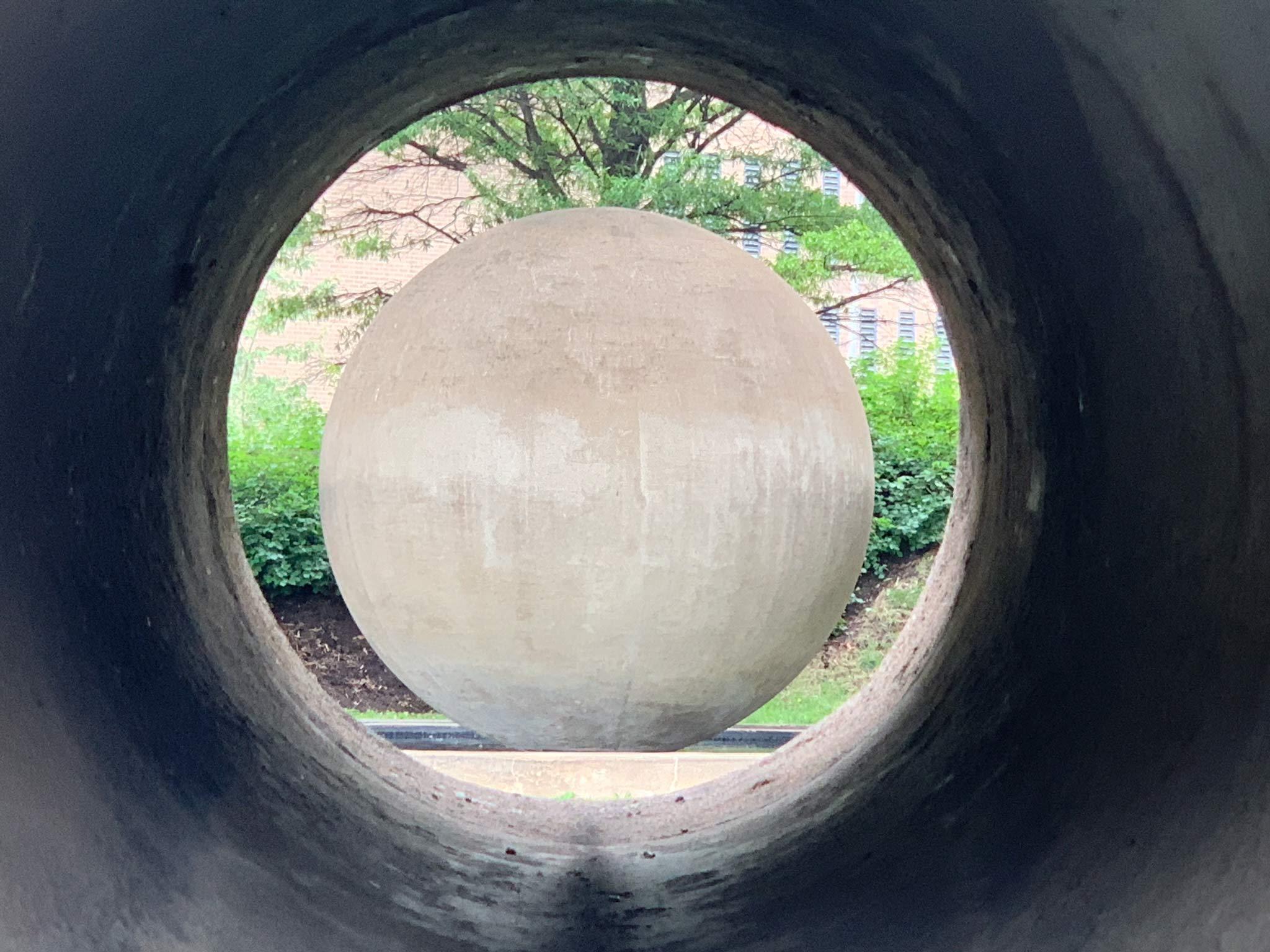Here Before & Where Beyond: "Dark Star Park"
. . . though we know perfectly well it is mere shadow,
we are overcome with the feeling that in this small corner
of the atmosphere there reigns complete and utter silence;
that here in the darkness immutable tranquility holds sway . . .
—Jun'ichirō Tanizaki, In Praise of Shadows1
*
Visiting Nancy Holt’s Dark Star Park (1979-1984) in Rosslyn, Virginia, you may walk among trees, reflecting pools, and cement spheres. In a car, you may bypass with barely a glance. Streets lead out of this suburban compression: north to Georgetown and south toward Arlington Cemetery, with highway onramps east to Washington, D.C. and west toward Virginia’s Blue Ridge Mountains.
Located at converging intersections, Dark Star Park is one of the first examples of “integrated public art.” Shadowed by high rise buildings, giant gunite balls scatter like marbles, forms that Holt conceived of as fallen stars.2 The stars constellate around a traffic circle, telescoped holes, crosswalks, and curved paths. A visitor can approach from almost any direction: around grass knolls, across a plaza, through a pedestrian tunnel. Byways become peripheral surrounding a map. YOU ARE HERE spirals out to other public artworks within walking distance.
Through the artwork of fallen stars, telescopic views pull the landscape into its gravitational orbit, reorienting here with an elsewhere that can be felt even in air that smells of exhaust fumes, hums with car traffic, and shudders from planes flying in and out of nearby National Airport. What a visitor cannot see hovers around curves. A bird’s eye view of Dark Star Park could place the Potomac River and Chesapeake Bay. Vistas hide behind office towers as concrete, glass, and brick crowd out views of wooded Roosevelt Island and green sweeps to the National Mall. Windows reflect fragmented sky.
Since the park’s construction, annually on August 1st around 9:32 a.m. people gather on a triangular traffic island to observe the artwork measuring time passing. Beside four steel poles and two gunite spheres, sun shadows align; over the years, the exact moment of alignment has shifted with the Earth’s axis. As Holt conceived, the convergence of shadows around these fallen stars marks the day in 1860 when William Henry Ross came to acquire land that would become Rosslyn: an origin story as shadowy as the artwork. Located a stone’s throw from Robert E. Lee’s home of Arlington, the site resides near the Potomac River that was considered the Mason-Dixon line. Annually, the convergence of sun shadows at Dark Star Park recognizes a property exchange on the brink of the Civil War. But the land has a longer cultural history buried under the asphalt, steel poles, and fallen stars.
*
Imagine a film in reverse where the annual sun alignment blips repeatedly back to 1984, to an abandoned gas station a few blocks from the “deep throat” garage of Watergate fame. Rewind as federal suburbs descend to car dealerships, pawnshops, lumber and brick yards, unsegregated saloons and businesses, trolley tracks connecting African American neighborhoods, rowhouses, and churches. Go back further through nearby Fort Myer and Freedman’s Village to signal stations among Union-commandeered posts in a Confederate state labored largely by enslaved Blacks. Before William Ross and his wife Caroline, neé Lambden, received land from her father amid plantations and farms, Virginia receded to D.C. receded to Virginia through generations of Masons (who on paper called it West or South Haven). Go further back through land grantees of Lord Fairfax to John Smith’s colonial British travels through Virginia in the early 1600s, when Smith mapped hundreds of Algonquin-speaking Native American communities that soon after were decimated by disease, discrimination, and drought.3 Histories of indigenous communities stretch back further thousands of years. Through deeper time, geologically, the North American plate connects the past to the future, tectonically shifting Dark Star Park as the Earth revolves around the sun: the star at the center of our solar system that spins us forward in time.
*
In late 2014, when I first moved to Washington, D.C., my husband and I lived in a small apartment a few blocks from Dark Star Park on a dead-end street called Ode. That winter, on foot we commuted past Dark Star Park not knowing its name or history, bundled in coats to the post office or to work across Key Bridge. We walked our dog, carried groceries and packages, seeing the park without seeing it. This is the way commuters go from destination to destination, overlooking the journey. Rosslyn has that effect: a glinting artificial city made for livelihood less than living. It rises above D.C.’s height restrictions, a modern commercial monument, spilling into apartment residences, staring down the nation’s Capital. It took a few years, after moving away, to notice what we had missed.
In late 2017 my commute shifted seasonally from D.C. to teach in Utah, where I visited Nancy Holt’s Sun Tunnels (1973-76) in the northwest part of the state in the Great Basin Desert. Immersing myself in Holt’s artworks, I chanced upon reference to Rosslyn. The location overlapped where I had walked repeatedly, so I returned at a distance through photographs. Through archival eyes, refocusing from Utah, a delayed recognition arose: YOU WERE THERE. Through visual echoes, my encounter became relational as time and space rotated.4
The more that I studied Holt’s work and returned to D.C., the more that I noticed unexpected sun tunnels in industrial cylinders, metro stations and freeway ramps, fallen stars in memorials among lineages of land art, in a city of landfills and levees at risk of flooding from rising seas.5 Holt’s work evokes shifting constellations—not only about stars but the space around them. A site of luminance or density redirects your sight to something else. The interplay organizes what might appear empty—as shadow helps you see light; as music resounds to amplify the shape of space; as death illuminates life.
*
My current home in Washington, D.C. lies about an hour’s walk from Dark Star Park. During COVID-19, on the first of August 2020, I walked with my husband across the river to watch the sun’s alignment. In a year often linked with vision (20/20), I did not know what to expect and whether people would come. A masked crowd encircled the traffic island. In humid morning heat, the sun was almost too bright for shadows. Congregating strangers shared wonder, even joy, amid grief, witnessing time in slow motion. All of us seemed to hold our breath, suspended, like the year that we were beholding. Sun and shadow aligned—a small miracle we could count on. Amid mass uncertainty, time did not stop. The event was not dramatic as a solar eclipse sucking light from the sky. We squinted and shaded our eyes to discern shadows. Masked and murmuring, we lingered. After quarantines and social distancing in a global pandemic, this brief act of joining with strangers offered a hopeful reminder. For that moment, we were alive together on this planetary sphere orbiting among stars.
*
The year 2020 will cast a shadow over any coinciding lifespan. Dark Star Park is likewise weighted by living history. The art occupies land that over centuries was dispossessed and resettled, raising questions of who belongs here and elsewhere. Over time and over seasons change emerges in watery pools (a feature Holt elsewhere likened to “eyes of the earth”), dotted by bird feathers and human trash under a verdant tree canopy, rusting in autumn, or dusted with snow.6 Integrated by a berm with an office building, the curated park evolves with Rosslyn’s development. In 1979 Dark Star Park was the first developer-commissioned project by Arlington Public Art, who has since realized more than seventy permanent artworks.7 The land continually evolves: as waterways drain toward the meteor-made Chesapeake Bay, as eroding ancestors of Appalachians residually join barrier islands of the Eastern Shore, as natural forces sculpt this region, intermixing elsewhere with here.
Over the past year, orbiting this artwork, my grounding in the mid-Atlantic has reoriented my sense of place. Dark Star Park evokes places beyond: never singular, ever relational, always constellating. Arrivals and departures coincide with others, placed and displaced. With many exits and entries, the artwork intersects histories, journeys, lives. Just as many have passed through here, more await recognition, with many directions to go.
Selected Bibliography
Bestebreurtje, Lindsey. Built by the People Themselves—African American Community Development in Arlington, Virginia, from the Civil War through Civil Rights (Dissertation in History, George Mason University, 2017).
Holt, Nancy. Art in the Public Eye: The Making of Dark Star Park (film, 1988).
Smith, John, and William Hole. Virginia. [London, 1624] Map. https://www.loc.gov/item/99446115/
Tanizaki, Jun'ichirō. In Praise of Shadows, trans. Thomas J. Harper and Edward G. Seidensticker (New Haven, CT: Leete’s Island Books, 1977).
Williams, Alena J. (ed.) Nancy Holt: Sightlines (Berkeley: University of California Press, 2011).
Thanks to Angela Adams, director of Arlington Public Art who worked with Nancy Holt (1938-2014) to restore and steward Dark Star Park. Thanks also to the Arlington Historical Society, Black Heritage Museum of Arlington, Georgetown University Archives, and the Library of Congress.
About the Author
Gretchen Ernster Henderson is an interdisciplinary writer whose publications cross books, libretti, and arts media. Her fifth book, Life in the Tar Seeps: A Spiraling Ecology from a Dying Sea (Trinity University Press) grew from researching Nancy Holt’s Sun Tunnels and Robert Smithson’s Spiral Jetty. An excerpt published in Ecotone was a Notable Essay in 2020 Best American Essays. Gretchen has taught at Georgetown, University of Utah, MIT, and is the former Associate Director for Research at the Harry Ransom Center at The University of Texas-Austin, where she is currently a Faculty Fellow in the Humanities Institute and Senior Lecturer in Social Work.
- 1Jun'ichirō Tanizaki, In Praise of Shadows, trans. Thomas J. Harper and Edward G. Seidensticker (New Haven, CT: Leete’s Island Books, 1977), p. 20.
- 2Dark Star Park is located in Rosslyn, Virginia, an urban neighborhood in Arlington County. The artwork was commissioned in 1979, with installation completed in 1984, and restored in 2002. Its materials include gunite (air-placed concrete, a sprayable mixture of cement and sand), earth, sod, gro-low sumac, willow oak, stone dust, stone masonry, asphalt, steel, and water. For background about visiting the site and Holt’s oeuvre, see Alena J. Williams, ed. Nancy Holt: Sightlines (Berkeley: University of California Press, 2011) and Arlington Public Art: https://publicart.arlingtonva.us/locations/dark-star-park/.
- 3For background about the cultural history of Arlington, among other sources see Lindsey Bestebreurtje, Built by the People Themselves—African American Community Development in Arlington, Virginia, from the Civil War through Civil Rights (Dissertation in History, George Mason University, 2017); Nancy Perry, Spencer Crew and Nigel M. Waters, “‘We didn't have any other place to live’: Residential Patterns in Segregated Arlington County, Virginia,” Southeastern Geographer, vol. 53, issue 4 (Winter 2013), pp. 403-427; and for earlier history, articles in Arlington Historical Society Magazine. Regarding indigenous recognition, today Virginia has 11 federally recognized tribes, and there is more to be acknowledged about Native living history around the region now called Washington, D.C.: https://www.arl.org/land-acknowledgment/
- 4In winter 2016 I saw a photograph of Nancy Holt’s Sun Tunnels in a library book in Rhode Island and took a photograph of that photograph, which I later re-encountered after visiting the site in Utah. Holt’s art constellates in unexpected ways. For instance, at times while researching “Dark Star Park,” I misremembered the artwork as “Dark Sky Park,” fusing it in my imagination with developing celestial reserves protecting the night sky from light pollution.
- 5In the regional orbit of Dark Star Park by Nancy Holt (1984) are memorials such as Vietnam Veterans Memorial by Maya Lin, dedicated in 1982, and wider lineages of land art including Always Becoming by Nora Naranjo-Morse (Santa Clara Pueblo), created in 2007.
- 6Holt was moved by a proverb attributed to the Seneca Nation: “Pools of water are the eyes of the earth.” See Nancy Holt, “Hydra’s Head,” in Williams, ed., Nancy Holt, p. 74; originally published in Arts Magazine 49, no. 5, special issue: Sculpture (January 1975), pp. 57-59. The name ‘coronavirus’ derives from ‘corona’ after the haloed appearance of each virion, seen under an electronic microscope, akin to the gaseous envelope around the sun and stars.
- 7Dark Star Park began a new chapter for Rosslyn and urban suburbs like it. In early plans for the integrated public art, the traffic island (site of alignment) was not included in the design. As Holt collaborated with others across city planning, development, architecture, art, astrophysics, construction and park maintenance, more land came into the artwork’s gravitational pull. The site was renovated around 2002 in consultation with the artist (who died in 2014). Another renovation is anticipated in coming years. Over decades since its creation, saplings have grown a tree canopy; invasive species have been removed; and recently adjacent streets were put on an “asphalt diet,” with planter boxes retrieving pavement for pedestrians. Slow streets and urban greening try to integrate a growing sense of place: WE ARE HERE.
Henderson, Gretchen Ernster. "Here Before & Where Beyond: 'Dark Star Park'." Holt/Smithson Foundation: Scholarly Texts Chapter 3 (February 2022). https://holtsmithsonfoundation.org/here-where-beyond-dark-star-park.

